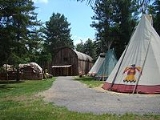
Mokotakan
Encyclopedia
Mokotakan is an open-air museum located in Saint-Mathieu-du-Parc
in the Mauricie
region of Quebec
, Canada. It traces the presence of aboriginal peoples in Quebec
for more than 5000 years. The eleven aboriginal peoples of Quebec represented at the site are Abenakis, Algonquins, Atikamekw
s, Cree
, Wendat, Innu (Montagnais)
, Inuit
, Maliseet, Micmac, Mohawk
, Naskapi
s. The interpretive village was constructed based on various buildings recovered from various sites from the eleven nations.
The mission of this site is the sharing, dissemination and interpretation of culture of indigenous peoples of the Americas
, with emphasis on the eleven nations of Quebec. A guided tour teaches visitors lifestyles, culture, history and spirituality of these peoples.
Mōkotākan means "crooked knife" in Atikamekw
, an indispensable tool of the eleven nations of Quebec.
, CHIN
, and Virtual Museum of Canada
.
Saint-Mathieu-du-Parc, Quebec
Saint-Mathieu-du-Parc is a municipality in the Mauricie region of the province of Quebec in Canada.It is home to the Mokotakan Museum, showcasing the First Nations of Quebec.-References:...
in the Mauricie
Mauricie
Mauricie is a traditional and current administrative region of Quebec. La Mauricie National Park is contained within the region, making it a prime tourist location. The region has a land area of 35,855.22 km² and a 2006 census population of 258,928 residents...
region of Quebec
Quebec
Quebec or is a province in east-central Canada. It is the only Canadian province with a predominantly French-speaking population and the only one whose sole official language is French at the provincial level....
, Canada. It traces the presence of aboriginal peoples in Quebec
Aboriginal peoples in Quebec
Aboriginal peoples in Quebec total 11 distinct nations. The 10 Amerindian nations and the Inuit nations number 71,415 people and account for approximately 1% of the total population of Quebec, Canada.-Inuit:...
for more than 5000 years. The eleven aboriginal peoples of Quebec represented at the site are Abenakis, Algonquins, Atikamekw
Atikamekw
The Atikamekw are the indigenous inhabitants of the area they refer to as Nitaskinan , in the upper Saint-Maurice River valley of Quebec , Canada. Their population currently stands at around 4500. One of the main communities is Manawan, about northeast of Montreal. They have a tradition of...
s, Cree
Cree
The Cree are one of the largest groups of First Nations / Native Americans in North America, with 200,000 members living in Canada. In Canada, the major proportion of Cree live north and west of Lake Superior, in Ontario, Manitoba, Saskatchewan, Alberta and the Northwest Territories, although...
, Wendat, Innu (Montagnais)
Innu
The Innu are the indigenous inhabitants of an area they refer to as Nitassinan , which comprises most of the northeastern portions of the provinces of Quebec and some western portions of Labrador...
, Inuit
Inuit
The Inuit are a group of culturally similar indigenous peoples inhabiting the Arctic regions of Canada , Denmark , Russia and the United States . Inuit means “the people” in the Inuktitut language...
, Maliseet, Micmac, Mohawk
Mohawk nation
Mohawk are the most easterly tribe of the Iroquois confederation. They call themselves Kanien'gehaga, people of the place of the flint...
, Naskapi
Naskapi
The Naskapi are the indigenous Innu inhabitants of an area they refer to as Nitassinan, which comprises most of what other Canadians refer to as eastern Quebec and Labrador, Canada....
s. The interpretive village was constructed based on various buildings recovered from various sites from the eleven nations.
The mission of this site is the sharing, dissemination and interpretation of culture of indigenous peoples of the Americas
Indigenous peoples of the Americas
The indigenous peoples of the Americas are the pre-Columbian inhabitants of North and South America, their descendants and other ethnic groups who are identified with those peoples. Indigenous peoples are known in Canada as Aboriginal peoples, and in the United States as Native Americans...
, with emphasis on the eleven nations of Quebec. A guided tour teaches visitors lifestyles, culture, history and spirituality of these peoples.
Mōkotākan means "crooked knife" in Atikamekw
Atikamekw language
The Atikamekw language , a dialect of Cree, is the language of the Atikamekw people of southwestern Quebec. It is spoken by nearly all the Atikamekw, and therefore it is among the indigenous languages least threatened with extinction according to some studies...
, an indispensable tool of the eleven nations of Quebec.
Affiliations
The Museum is affiliated with: CMACanadian Museums Association
The Canadian Museums Association is a national organization for the promotion of museums in Canada.The Canadian Museums Association is the national organization for the advancement of the Canadian museum sector, representing Canadian museum professionals both within Canada and internationally. The...
, CHIN
Canadian Heritage Information Network
The Canadian Heritage Information Network is a Canadian government-supported organization that provides a networked interface to Canada's heritage, largely through the World Wide Web. It aims to give access to Canada's heritage for both Canadians and a worldwide audience, by supporting the...
, and Virtual Museum of Canada
Virtual Museum of Canada
The Virtual Museum of Canada is Canada's national virtual museum. With a directory of over 3,000 Canadian heritage institutions and a database of over 600 virtual exhibits, the VMC brings together Canada's museums regardless of size or geographical location.The VMC includes virtual exhibits,...
.

